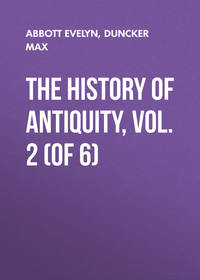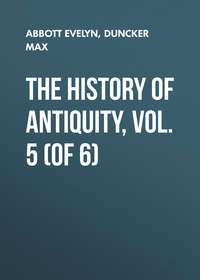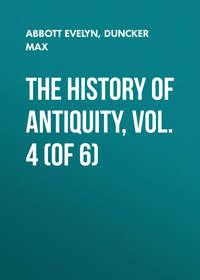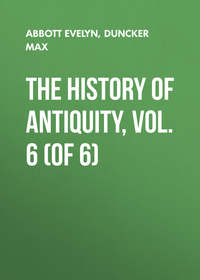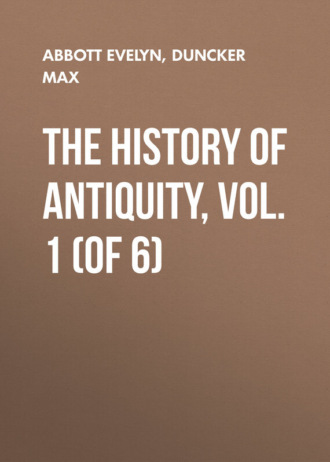 полная версия
полная версияThe History of Antiquity, Vol. 1 (of 6)
East of the Carians, on the south coast, in the valley of the Xanthus, were the settlements of the Lycians. The range of Taurus, which here rises to a height of 10,000 feet, sinks down in fields of snow and Alpine pastures to the course of the Xanthus. The sides of this valley, Mounts Kragus and Anti-Kragus, are beautifully wooded, and traversed by sounding rills. The view extends from the upper course of the river over the luxuriant vegetation of the plain down to the sea.
Herodotus tells us that this district was once known as Milyas, and that the Lycians, who were originally called Termilians, immigrated from Crete. Sarpedon and Minos contended for the throne, and as Minos got the upper hand, Sarpedon went with the Termilians to Asia, and took possession of Milyas. Afterwards Lycus, the son of the Attic king Pandion, when driven out by his brother Aegeus, came to Sarpedon, and from him the Termilians got the name of Lycians. Their laws were Cretan and Carian. They wore hats adorned with feathers, goat skins round their shoulders, sickle-shaped swords and daggers, coats of mail, greaves, bows, and arrows of reeds. They were named after the mother, and not after the father, and spoke of the mothers of their mothers as their ancestors. The son of a free woman and a slave was free and passed for a well-born man; but if a free man, even the first among them, begot children with a foreign woman or a concubine, these were outlaws.852 Heraclides of Pontus extends these statements so far as to assert that the Lycians from ancient times had been under the dominion of their wives; Nicolaus, of Damascus tells us that the daughters of the Lycians, and not the sons, took the inheritance.853
In the Homeric poems, Prœtus, king of Argos, sends Bellerophontes of Ephyra (Corinth) to the king of the Lycians, to be put to death. The king bade him slay the Chimæra, a monster which was a lion in front, a goat in the middle part, and a dragon behind, and when he succeeded in this he sent him to fight against the Solymi and the Amazons. But afterwards he gave him half his kingdom and his daughter, who bore him Hippolochus and Laodameia. The son of Hippolochus was Glaucus, and the son of Laodameia was Sarpedon, the chieftains who led the Lycians to the aid of the Trojans.
Beside the supposed immigration of the Lycians from Crete and the poetry of Homer we know nothing of the history of the Lycians beyond the fact that they did not submit to the army of Cyrus without a most obstinate resistance. And even under the supremacy of the Persians the Lycians managed their internal affairs independently. They formed a federation which was in existence at Strabo's time, and then included twenty-three places. Each city was represented at the assembly; the six larger cities had three votes each, the next largest had two, and the smaller cities had one.854
The name Milyas, which, according to Herodotus, was borne by the valley of the Xanthus, clung even in later times to the spur under the ridge of Mount Taurus, which runs out eastward towards Mount Solyma. Hence the Lycians could easily be represented as in conflict with the Solymi. The name Chimæra is given to a high mountain valley on Mount Kragus.855 If the Greeks call the inhabitants of the valley of the Xanthus Lycians, the name has not arisen among them from the supposed Lycus, the brother of Ægeus, but rather from the Grecian god of light, Apollo Lyceus. According to the mythus of the Greeks, Apollo Bellerophontes (who was worshipped at Corinth), dashes down from his cloud-horse and with his crown of rays breaks through the thick clouds which obscure the sun; he overcomes Bellerus, the spirit of darkness. In the mind of the Greeks, Lycia was free from the clouds of winter; and, as a fact, the climate of the valley of the Xanthus is excellent. Into this bright land, therefore, the god was thought to have marched when he had become a hero; here he overcame the Chimæra, the creature of mist and cloud. The Greeks went still further in this conception. The east, the land of sunrise, was in itself the land of light, of the god of light, Lyceus. The god of light was thought to pass the winter in the brighter east, in the home of the sun. When the Greek colonists had settled on the western coasts of Asia Minor, they regarded the valley of the Xanthus as the eastern land of light, they gave it this name, and supposed that Apollo passed the winter in Lycia, and gave oracles during the six winter months at Patara in Lycia.856 In spite of the eastern situation and the climate of Lycia, this idea would hardly have taken root had not the Lycians at Patara, and probably at other places in Lycia, worshipped a god in whom the Greeks could recognise their own god of light. The Homeric poems place the Lycians in the closest connection with the Teucrians. There is a Xanthus in Lycia and in the Troad, and the name Tros seems to be identical with the name of the Lycian city of Tlos, which lies high up in the valley of the Xanthus under Taurus. In any case, from this close combination of the Teucrians and Lycians in Homer, we may conclude that with the Greeks of the coast the Lycians passed for a tribe who had already been for a long time in possession of their settlements. None but native Asiatic tribes could be represented as fighting beside the native Teucrians as their closest confederates.
The Lycians developed a peculiar civilisation and a peculiar art, of which numerous monuments, and many of them accompanied by inscriptions, have come down to us. The alphabet in these inscriptions closely resembles the Greek. With the aid of some inscriptions written in the Greek and Lycian languages, scholars have succeeded in fixing the value of the Lycian letters – of which there are ten for vowels and diphthongs, and twenty for consonants.857 By this means we have become acquainted with the name by which the Lycians called themselves. They were not merely called Termilians, as Herodotus supposed, in the most ancient times, but even in their own inscriptions they call themselves Tramele. The city which the Greeks calls Xanthus is in the language of the Tramele, Arna; the city of Patara is Pttarazu; Pegasa is Begssere.858 In fixing the character of the Lycian language, it was at first supposed that the Lycians might have been a branch of the Phrygians, who had forced their way over the Taurus to the south coast – an assumption which seems to be supported by the fact that the Lycian monuments resemble the Phrygian in plan and style; and that the Lycians, like the Phrygians, loved to excavate walls of rock and that in Lycia, as in Phrygia, the influence of the Greeks was felt at an early time. But the Lycian idiom, so far as the remains of it have been examined at present, was distinctly different from the Phrygian language. While some of our scholars find in the Lycian language words and inflexions allied to the Albanian, i. e. to the remains of the language of the ancient Illyrians, others are more inclined to place the Lycian in close connection with the Iranian languages.859 In either case the Lycians, like the Armenians and Phrygians, belong to the Indo-Germanic stock, and not only the Armenians and Phrygians, but along with them the forefathers of the Lycians came into Asia Minor from the north-east.
The Lycians were settled in a region of strong natural boundaries, and of a very defined and picturesque form. The position of their land, protected as it was by strong natural boundaries, secured for them a more undisturbed development than was possible to the other tribes of Asia Minor. Their cities and towers, Xanthus, Phellus, Myra, Telmissus, Patara, Pinara, and Tlos were surrounded by strong walls of Cyclopian architecture, and the splendid remains are evidence of great skill in masonry. The noble ruins of Xanthus, not far from the mouth of the river of the same name, still proclaim, even at a distance, the ancient metropolis of the Lycians. How far back the monuments of Lycia extend cannot be determined as yet. The oldest of which the date can be fixed go back to the reign of Darius II., the Itariayush of Lycian inscriptions. The reliefs exhibit the Chimæra, as described in Homer; and they repeatedly exhibit a lion slaying a bull.860 The Lycians themselves are represented in long garments, just as in works of Greek art; and even to this day the peasants on the Xanthus are to be seen in the caftan.861 Pictures of battles, of agricultural and pastoral occupations are frequent on the monuments; but so far as the inscriptions have been deciphered at present, they afford no single instance in support of the statement of Herodotus that the Lycians were not named after the father, but after the mother.862 The most important remains are the tombs, which are evidence of the great industry and care which the Lycians devoted to the repose and memory of the dead. A considerable number of these tombs lie within the walls of the city, and are surrounded by the ruins of other buildings. Hence the dwellings of the dead and of the living were not separated among the Lycians. Besides sarcophagi, made of blocks brought for the purpose, we also find detached rocks, which are changed into great sarcophagi, rocky peaks transformed into sepulchres, and extensive walls of rock, in which grave-chambers have been cut. The face of the rocky wall, thus hollowed out for tombs, is provided with façades which rise up in rich variety to the number of many thousands, over and alongside of each other, sometimes advancing, sometimes receding, according to the nature of the rock. The style of these tombs, which is for the most part very delicate and slender, is an imitation of a kind of wooden structure, which must have been common in Lycia in ancient times, and the simplest forms of which are still in use among the peasants of the region which corresponds to Lycia;863 sometimes the structure is simpler, at others more complicated, and the effect is strengthened by delicate and luxuriant ornamentation. The faces of the rock-tombs sometimes end with a flat framework of beams, at others with a gable in low relief. The detached sepulchres exhibit the same imitation of a wooden building. Many of these sepulchres are obviously intended for three corpses; in the single chamber included in them are generally found two stone benches in the sides and at the back a receptacle for a corpse in a recess.864 The detached sarcophagi are the most numerous. On a sub-structure, or immediately on the ground, stands a long stone coffin, closed by a high massive cover, the section of which exhibits a Gothic pointed arch. On these sarcophagi also the ornamentation is almost always rich, and carried out with neatness even to the smallest detail. Beside the sarcophagi we also find pillars and obelisks among the ruins. The tympana, friezes, and surfaces of all these monuments are covered with reliefs, which represent with much truth and liveliness the life of animals as well as the life of men. Evident remains of colouring on all the monuments show us that a layer of lively and even startling colours was laid upon these buildings. The reliefs also were painted, and some are treated almost as pictures. The inscriptions upon the tombs prove that the Lycians erected these tombs in their lifetime for themselves, wives, and children, and that this was done by several families in common; they invoke the anger of a goddess Phate – whom the Greeks call Leto – on those who might dare to violate them. From the nature and solidity of these tombs and sarcophagi, it is clear that the Lycians were almost at as much trouble to give a secure resting-place to their dead as the Egyptians were to give rest to their mummies, while the ornaments show that the Lycians must have regarded the life after death as a state of peaceful repose; the sculptures on the tombs invariably represent friendly scenes of family life, of occupation in the country, of social life or festal enjoyment. We see mothers with their children, carriage journeys, riders, processions, banquets, and feasts, and finally battle-pieces, in which the combatants are partly armed as Lycians and partly as Greeks. Nothing, not even in the pictures of battles, reminds us of the horrors of death, or of a judgment in the under world. The monuments of Lycia prove that the supremacy of the Persians did not interrupt the progress of Lycian art. But the creations of the later period enable us to see that Greek art, in her bloom, obtained and exercised the strongest influence over the Lycians. The most beautiful monument of Lycia, the tomb of Harpagus, the Persian satrap, which belongs to the first half of the fourth century, exhibits a preponderance of Greek forms.
THE END1
Bunsen, "Ægypten," 5, 1, 75 ff.; Ebers, "Ægypten and die Bücher Moses," p. 43; Renan ("Histoire générale et système comparé des langues Sémitiques") will not admit this close connection.
2
Brugsch ("Histoire d'Egypte," pp. 5, 6) explains the name Egypt by ha-ka-ptah, i. e. "the precinct of Ptah." As Ptah was more especially the god of Memphis, this name would have come from Memphis. The attempt has been repeatedly made to derive the civilisation of Egypt from Ethiopia and Meroe. But the problem of the origin of a given civilisation is not solved by removing it from the locality where it exists in full bloom to another, and as a rule more unknown, district. In the case before us this assumption is met by the peculiar difficulty, that the culture of Egypt is influenced essentially by the nature of the land, and therefore can hardly have had an external origin. It cannot be removed from a highly favoured locality into a district extremely hot, and fruitful only in detached oases, without making the explanation of its origin much more difficult. Moreover, the lower valley of the Nile has always ruled over the upper: even in mediæval and modern times. The inscriptions of Sargon, king of Assyria (722-705 B.C.), mention the king of Meroe (Miluhhi); those of Sennacherib (705-681 B.C.) tell us, "The kings of Egypt have summoned the archers, the chariots, the horses of the king of Miluhhi." The inscriptions of Esarhaddon (681-668 B.C.) speak of the "King of Egypt and Miluhhi," whom they also name "King of Egypt and Cush;" and the successor of Esarhaddon directed his first campaign against "Tarku" (Thirhaka) "of Egypt and Miluhhi." The word Meroe, therefore, as the name of a kingdom lying above Egypt on the Nile, must have been in use in Syria, even in the eighth century B.C. Hence the Greeks denote by this name an island, and also a city of the Upper Nile. According to Herodotus (2, 29) the great city Meroe, "which ought to be the chief city of the rest of the Ethiopians" (i. e. of those of whom the Egyptians were not the immediate neighbours), was forty days' journey and twelve days' sail (i. e. over 15,000 stadia) above Syene. Later authorities, Eratosthenes, Artemidorus, Strabo, Pliny, Ptolemy reduce the distance by nearly one-half; they regard the distance between Meroe and Syene as nearly equal to the distance from Syene to Alexandria, and fix the whole distance from Alexandria to Meroe at 10,000 to 12,000 stadia. As the town and island of Meroe must be south of the junction of the Astaboras (Atbara), (Strabo, p. 786), we must look for the island between the Atbara and the Blue Nile, and for the city in the ruins at the modern Begerauieh. Yet the chief town of the kingdom of Meroe, when it takes an active part in history, is not Begerauieh. King Thirhaka's residence lay near the modern Meraui under Mount Barkal. The name in inscriptions is Neb, and, consequently, in Greek and Latin Napata. Even under the Sesurtesen and Amenemha, Egypt ruled over Nubia as far as Semne and Kumna, under Amenophis III. as far as Soleb, and under Ramses II. as far as Mt. Barkal. The oldest ruins at this spot belong to a temple dedicated by this king to Ammon (Lepsius, "Reisebriefe," s. 238); next come the ruins of the buildings of Thirhaka, which differ as little from Egyptian buildings as those which he and his two Ethiopian predecessors erected in Egypt. Moreover, the later ruins found at Napata, especially some twenty small pyramids, are feeble imitations of Egyptian art. The same character of imitation is stamped upon the monuments of Begerauieh, though here it is mingled with foreign elements. This place, further removed from Egypt, and therefore more secure, was beyond doubt the residence of the kings of Meroe, at least from the time of Cambyses, and it was named after the country. Herodotus points out that Zeus and Dionysus, i. e. Osiris, were worshipped here, and that the oracle of Zeus, i. e. of Ammon, extended its authority over the Ethiopians: the further accounts which Diodorus preserves of this priesthood give a poor idea of their cultivation (3, 3 ff. Strabo, pp. 827, 828). At the time of the second Ptolemy, this priesthood was destroyed by the King, Ergamenes, whose name (Arkamen) Lepsius has discovered on ruins at Mt. Barkal, as well as Begerauieh, and an independent monarchy was established. Hence we must entirely give up the idea of deriving the supposed supremacy of the priesthood in Egypt, a supremacy which never existed here, from the priesthood formed at Begerauieh after the time of Thirhaka and Psammetichus (in the days of Psammetichus, Herodotus tells us that a king of the Ethiopians received strangers without an oracle, and gave them land, 2, 30); that is, in the sixth century B.C., which continued to exist till 250 B.C. Still less reason is there to suppose that the so-called Indian supremacy of the priesthood came through Meroe into Egypt. Rather we may feel ourselves justified in assuming that the elements of civilisation which took root on the middle Nile passed from Egypt to that district. In the inscriptions of Begerauieh the name Meroe occurs as Meru, and Merua, i. e. "White rock"; Lepsius, l. c. 205-232. As the banks of the Nile, here and also at Mt. Barkal, consist of whitish-yellow chalk rocks, the name of the land and its southern metropolis, of which the existence since the sixth century B.C. is demonstrated, may have been named from this peculiarity of the land.
3
"Il." 9, 381; "Od." 4, 230 ff. 477, 581. 14, 257, 264 ff. 17, 426.
4
Herod. 2, 2; Diod. 1, 10, 50; Plat. Tim. p. 23.
5
Herod. 2, 100, 142, 143.
6
Plato, "Tim." p. 23; "De Leg." p. 657.
7
Diodorus, 1, 44, 45, Olympiad 180, i. e. between 60 and 56 B.C.
8
Or, according to another version, more than 10,000 years from Osiris to Alexander. More than 10,000 years had passed, according to the Egyptians, since the creation of the first man. – Diod. 1, 23, 24.
9
Diod. 1, 13, 14.
10
Ibid. 1, 69.
11
Diod. 1, 63.
12
Syncell. p. 91, ed. Goar.
13
Syncell. p. 12.
14
Bœckh, "Manetho," p. 395.
15
"C. Apion." c. 14, 26.
16
Bœckh, "Manetho," p. 769 ff.
17
Reinisch reckons 389 kings from Menes to Cambyses, "Zeitschrift d. d. M. Ges." 15,251; Brugsch's table gives 334 royal shields from Menes to Cambyses.
18
According to Bœckh's "Kanon des Africanus."
19
This, like the following dates, is from Lepsius, see below.
20
Not including the thirty-eight shepherd kings; if these are added the number reaches 322.
21
Dümichen and Lepsius, "Zeitschrift für Aegyptische Sprache," 1864, p. 81 ff. Deveria and Mariette, "Revue Archéolog." 1865, p. 50 ff; 1866 (13), p. 73 ff.
22
Mariette in "Revue Archéolog.," 1864 (10), p. 170.
23
Brugsch, "Hist. d'Egypte," pp. 20, 44, 72; Devéria, loc. cit. p. 58 ff.
24
P. 98.
25
Gutschmid in the "Philologus," 10, 672.
26
The number of 113 generations, which Syncellus gives as contemporaneous, does not in the least agree with the accounts of Manetho; moreover, Gutschmid has shown from what items the number 3,555 in Syncellus has arisen in "Beiträge zur Geschichte des alten Orients," s. 9.
27
On this rests the difference of the systems of Lepsius and Bunsen. Taking the total given by Syncellus from Manetho of 3,555 years before Nektanebös, Lepsius arrives at the years 3,892 B.C. Bunsen also considers the number 3,555 to be from Manetho, but without historical value. He insists on this number because he allows Manetho to reckon 1,286 years for the new monarchy, 922 years for the Hyksos, and 1,347 years for the old monarchy; but for these 1,347 years he substitutes the 1,076 years of Eratosthenes, in order to fix the historical accession of Menes. According to this, Menes began to reign in the year 3284 B.C. From this, Reinisch ("Zeitschrift der Deutschen morgenl. Gesell." 15, 251 ff.) has attempted to reconcile the systems of Bunsen and Lepsius. He retains the total of 3,555 years, and the year 3,892 B.C. for Menes; to the 1,076 years given by Eratosthenes for the old monarchy he adds four years for Skemiophris, thus making 1,080 years, fixes the middle monarchy – the Hyksos – at 1,088 years, or down to the era ἀπὸ Μενοφρέως at 1,490, and the new monarchy down to Nektanebos at 985 years.
28
Bœckh, "Manetho," s. 411; Lepsius, "Chronologie," s. 148 ff. Th. Martin "Mém de l'Acad. d'Inscr," 1869 (8), 265 ff.
29
Bœckh, "Manetho," s. 404. In the decree of Kanopus, belonging to the ninth year of the reign of Ptolemy Euergetes, i. e. to the year 238 B.C., we find as follows (Lepsius, "Das Bilingue Decret von Kanopus"): "In order that the seasons of the year may continue to observe their time according to the present arrangement of the world, and that feasts which ought to be celebrated in winter may not be celebrated in summer, because the star advances one day in every four years, while others which are celebrated in summer will in later times be celebrated in winter, as has already happened, and will happen again, if the year is to be composed of 360 days, and the five days usually added, from henceforth a day shall be kept as the festival of the Divi Euergetes, every fourth year after the intercalary days, before the new year." That the discovery of the want of a quarter of a day was made before the time of Ptolemæus Euergetes I., and that for a long time computations were made by the fixed year with an intercalary cycle every fourth year, as well as by the movable year, is beyond doubt. The decree did not become of universal application till 26 B.C.
30
Herod. 2, 142.
31
Bœckh, "Manetho," s. 36; Lepsius, "Chronologie," s. 193.
32
According to Bœckh's "Kanon des Africanus."
33
Lepsius, "Königsbuch," s. 118. Biot, "L'Année vague," p. 57; cf. however H. Martin, "Mém. de l'Acad. des Inscript." 1869, pp. 1, 8, 265.
34
Herod. 3, 37.
35
De Rougé, "Revue archéolog." 1860, 1, 357.
36
"De Isid." c. 51, 52; "De Pyth. Oraculis," p. 400.
37
Macrob. "Sat." 6, 18.
38
"De Isid." c. 36.
39
De Rougé, "Zeitsch. d. d. m. Gesellschaft," after a sepulchral pillar in the Berlin Museum, 4, 375.
40
Champollion, Monuments, pl. 123 seq. Dümichen, "Tempelinschriften." 1, 24. Lepsius, "Aelteste Texte des Todtenbuchs," s. 13.
41
Lepsius, "Die Götter der vier Elemente;" Dümichen, in "Zeitsch. für ægyptische Sprache," 1869 s. 7.
42
Herod. 2, 61.
43
Plut. "De Isid." c. 38.
44


